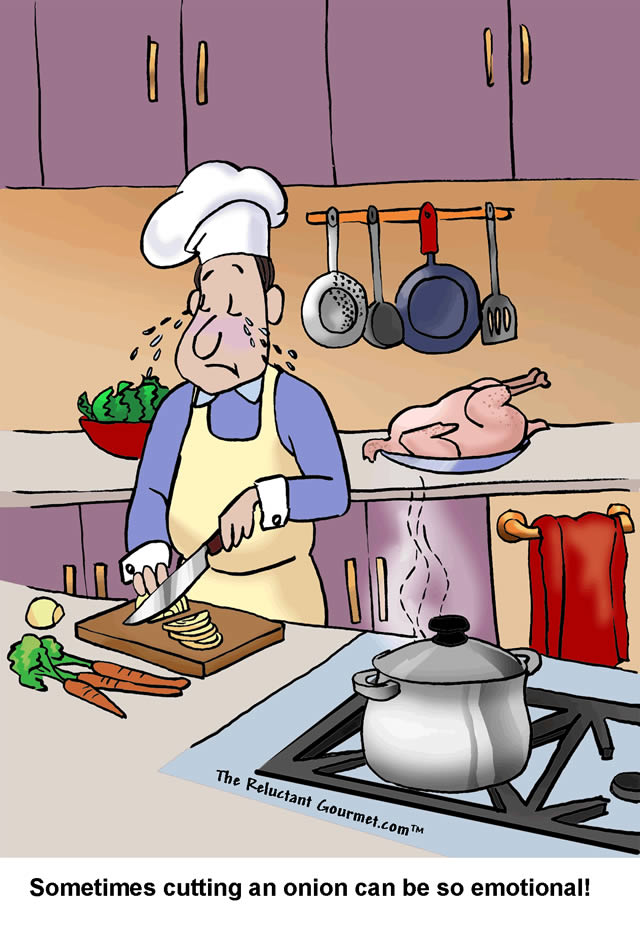Do Cutting Onions Make You Cry?
Of course they do unless you’re wearing Onion Goggles, as we do in our house. I’m hoping these cartoons will add a little humor to some everyday cooking situations you may have found yourself in.
Use of cartoons
These cartoons are all copyrighted so please do not use them in any way without permission.
What Makes You Cry When Cutting Onions?
Onions, the tear-jerking enigma, have long fascinated scientists and chefs with their unique ability to make us cry. This intriguing phenomenon, rooted in the onion’s distinctive chemical makeup, has been a puzzle for centuries.
Deep within the onion’s cells, a chemical drama unfolds. Special enzymes and sulfur compounds, each stored in their own compartments, await release. When you slice into an onion, you start a chain reaction, causing these chemicals to mix and react. One of the key players in this drama is alliinase, an enzyme that converts amino acids sulfoxides (such as isoalliin) into sulfenic acid.
The sulfenic acid, in turn, rearranges itself into a volatile gas known as syn-propanethial-S-oxide. This gas acts as the irritant, stimulating sensory neurons in your eyes’ lachrymal glands and triggering the production of tears. Tears are the body’s natural response to flush out the irritating substance and protect the eyes’ delicate tissues.
Interestingly, not all onions induce the same level of tearfulness. An onion’s pungency depends on its sulfur content, variety, and age. For instance, sweeter onions like Vidalia or Walla Walla have lower sulfur content, thus producing fewer tears when sliced. On the other hand, pungent varieties like yellow onions contain more sulfur compounds, making them more tear-inducing.
The sulfenic acid, in turn, rearranges itself into a volatile gas known as syn-propanethial-S-oxide. This gas acts as an irritant, stimulating sensory neurons in your eyes’ lachrymal glands and triggering the production of tears. Tears are the body’s natural response to flush out the irritating substance and protect the eyes’ delicate tissues.
Interestingly, not all onions induce the same level of tearfulness. An onion’s pungency depends on its sulfur content, variety, and age. For instance, sweeter onions like Vidalia or Walla Walla have lower sulfur content, thus producing fewer tears when sliced. On the other hand, pungent varieties like yellow onions contain more sulfur compounds, making them more tear-inducing.
Several methods have been devised to minimize onion-induced tears, although none are foolproof. Some suggest chilling the onion before slicing it to slow the enzyme reaction. In contrast, others recommend cutting the onion under running water or using a sharp knife to reduce cell damage and gas release. Additionally, wearing goggles or chopping onions near a vent or under a range hood can help dissipate the irritating gas.
Despite the tears they provoke, onions remain a staple in cuisines worldwide for their unique flavor and versatility in cooking. From caramelized onions adding sweetness to savory dishes to raw onions providing a zesty crunch in salads, their culinary importance far outweighs the temporary discomfort they cause.
Beyond their culinary applications, onions have also been studied for their potential health benefits. They are rich in antioxidants, particularly flavonoids and sulfur-containing compounds, and are linked to various health benefits, including reduced risk of heart disease and certain cancers.
Onions make us cry due to a complex chemical reaction that releases an irritating gas when their cells are damaged. While this tearful experience may be inconvenient, paying for these versatile vegetables’ culinary and nutritional benefits is a small price. So next time you shed a tear while chopping onions, remember, it’s just chemistry in action.
Ways to Prevent Onion Crying
Preventing onions from making you cry can be challenging, but there are several methods you can try to minimize tears:
- Chill the onion: Place the onion in the refrigerator for about 30 minutes before cutting. Chilling the onion can help slow down the release of the irritating compounds and reduce the intensity of the gas.
- Cut under running water: Cutting onions underwater can help wash away the volatile compounds released when you slice into the onion. This method can be effective in reducing eye irritation.
- Use a sharp knife: A sharp knife creates cleaner cuts with less cell damage, which can help minimize the release of irritants. Dull knives crush more cells, leading to more gas being released.
- Cut near a vent or under a range hood: Cutting onions near or under a range hood can help dissipate the irritating gas and reduce its concentration in the air around you.
- Wear goggles or glasses: Wearing goggles or glasses with a tight seal can create a barrier between your eyes and the onion vapors, preventing them from reaching your eyes and causing irritation.
- Cut quickly: Minimize the time spent cutting onions by working efficiently and cutting them as quickly as possible. The longer it takes to cut the onion, the more time it has to release irritants into the air.
- Use sweet onions: Sweet onions, like Vidalia or Walla Walla onions, have lower sulfur content and are less likely to induce tears than more pungent varieties, like yellow onions.
- Soak in water: Some people suggest soaking onions in water for a few minutes before cutting to reduce their pungency and minimize eye irritation. However, this method may also dilute the onion’s flavor.
Experiment with these methods to find the one that works best for you. While these techniques can help reduce tears when cutting onions, none of them are guaranteed to eliminate the problem entirely.








One Response
Great stuff Chef…when will we see the
Reluctant Gourmet on FOOD TV???